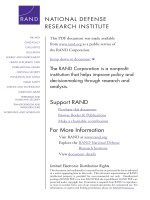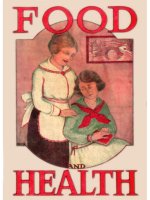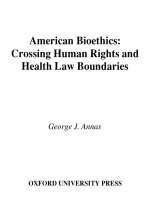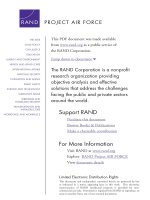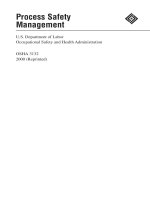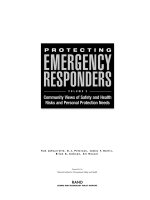2015 IFIC Food and Health Survey Health Professional Webcast
Bạn đang xem bản rút gọn của tài liệu. Xem và tải ngay bản đầy đủ của tài liệu tại đây (2.56 MB, 62 trang )
International Food Information Council Foundation
Food and Health Survey 2015
IFIC Foundation
Mission:
To effectively communicate science-based information on health, nutrition,
and food safety for the public good.
Primarily supported by the broad-based food, beverage and agricultural industries.
Visit us @ www.foodinsight.org
2
International Food Information Council Foundation
Food and Health Survey 2015
Continuing Education
Participants of this live-event webcast who are
Registered Dietitians or Dietetic Technicians,
Registered are eligible for
1.0 Continuing Education
Units from the Academy of Nutrition and Dietetics.
An email will be sent one hour after the completion
of this webcast with a link to download the
certificate.
Continuing Education is only available for those pre-
registered for the live webcast today.
3
International Food Information Council Foundation
Food and Health Survey 2015
Learning Objectives
Explain the variety of influences on consumer purchasing decisions.
Identify barriers preventing consumers from taking more control over
their health.
Describe areas of misinformation, confusion and lack of
understanding related to nutrition and health.
Distinguish ways to improve food and health communications to
empower consumers to take control of their diets, physical activity,
and weight.
4
International Food Information Council Foundation
Food and Health Survey 2015
Today’s Speakers
Marianne Smith Edge, MS, RD, LD, FADA
Senior Vice President, Nutrition and Food Safety
Kris Sollid, RD
Director, Nutrients
Sarah Romotsky, RD
Director, Health and Wellness
Liz Sanders, MPH, RD
Manager, Food Safety
IFIC Staff
5
International Food Information Council Foundation
Food and Health Survey 2015
• This report presents the results of an online survey of 1,007 Americans ages 18 to 80.
• 2015 marks the 10
th
anniversary of the Food & Health Survey, allowing for trend analysis for
many questions.
• Fielding took place from March 13 to March 26, 2015.
• The duration of the survey was 29 minutes, on average.
• The results were weighted to ensure that they are reflective of the American population ages
18 to 80, as seen in the 2014 Current Population Survey. Specifically, they were weighted by
age, education, gender, race/ethnicity, and region.
• The survey was conducted by Greenwald & Associates, using ResearchNow’s consumer panel.
Background & Methodology
2015
6
International Food Information Council Foundation
Food and Health Survey 2015
IFIC Foundation Food & Health Survey
• There is a disconnect between consumers’ perceptions of their weight status and health which
may interfere with the desire to make diet and behavior changes.
• Messages often fail to relate nutrients to foods we eat.
• Guidance to reduce intake of specific nutrients may be resented and therefore ignored.
• Food and nutrition practitioners, specifically RDNs, are underutilized.
• Future dietary guidance needs to address behaviors by understanding where consumers are.
• As the science-based experts in nutrition, RDNs must earn consumers’ trust as an authentic
source for advice rather than just delivering information.
10 Year Insights
7
International Food Information Council Foundation
Food and Health Survey 2015
2015 IFIC Foundation Food & Health Survey
• Americans’ perceptions of their health do not always match up with reality.
• Consumers have competing priorities that sometimes outweigh making health-related
behavior changes.
• An economic divide may be emerging in food purchasing behaviors.
• Despite the variance in consumers’ interests in food, taste is still the top consideration.
• Americans want positive guidance to help them make sense of conflicting messages.
Key Findings
8
9
Diet and Health
International Food Information Council Foundation
Food and Health Survey 2015
Who is more likely to report being in better health?
• College grads
• Women
• Higher income
• Lower BMI , no non-communicable diseases
17%
40%
33%
8%
1%
18%
42%
31%
7%
2%
19%
43%
30%
7%
2%
Excellent Very Good Good Fair Poor
2015 2014 2013
2015 n=1,007; 2014 n=1,005; 2013 n=1,006
Consistent with previous years, more than half of Americans rate their own
health as excellent or very good.
How would you describe your own health in general?
57%
ARE IN EXCELLENT/VERY GOOD HEALTH
10
Diet and Health
International Food Information Council Foundation
Food and Health Survey 2015
42%
27%
28%
3%
23%
32%
41%
4%
13%
26%
58%
2%
Normal or low
Overweight
Obese
Refused to provide
height/weight
Excellent/Very Good
Good
Fair/Poor
BMI Score
Self-Reported Health
Half of Americans who see themselves as in excellent or very good health are
overweight or obese.
17%
15%
8%
7%
4%
3%
2%
2%
1%
<0.5%
62%
24%
31%
9%
14%
13%
3%
5%
2%
4%
<0.5%
42%
41%
45%
20%
31%
25%
4%
7%
6%
9%
1%
25%
High cholesterol
High blood pressure
Overweight/Obesity
Stress/Anxiety/Depression
Diabetes
ADHD
Heart disease
Osteoporosis
Cancer
Stroke
None of the above
Currently Being Treated For…
11
Diet and Health
International Food Information Council Foundation
Food and Health Survey 2015
48%
44%
7%
1%
51%
40%
7%
2%
56%
40%
3%
1%
A lot A little None Not sure
2015 2014 2013
Over the past year, how much thought have you given to the healthfulness of the foods and
beverages you consume?
2015 n=1,007; 2014 n=1,005; 2013 n=1,006
Arrows indicate significant (.95 level) differences vs. prior year(s); color of arrow indicates comparison year.
In 2015, almost half of all Americans have given a lot of thought to the
healthfulness of foods and beverages they consume.
Who is more likely to have given
a lot
of
thought to the healthfulness of what they
consume?
• College grads
• Women
91%
THOUGHT ABOUT HEALTHFULNESS
OF FOODS/BEVERAGES
12
Diet and Health
International Food Information Council Foundation
Food and Health Survey 2015
Who is more likely to have given
a lot
of
thought to the amount of physical activity
they get?
• Those in better health
• College grads
• Women
53%
41%
5%
1%
56%
35%
8%
1%
60%
37%
4%
<.5%
A lot A little None Not sure
2015 2014 2013
Roughly half of all Americans have given a lot of thought to the amount of
physical activity they get. Compared to 2014, fewer now say they have given
no thought to their physical activity.
Over the past year, how much thought have you given to
the amount of physical activity you get?
2015 n=1,007; 2014 n=1,005; 2013 n=1,006
Arrows indicate significant (.95 level) differences vs. prior years
94%
THOUGHT ABOUT PHYSICAL ACTIVITY
‘14
‘14
‘13
13
Diet and Health
International Food Information Council Foundation
Food and Health Survey 2015
36%
31%
29%
20%
20%
20%
17%
16%
13%
11%
7%
7%
6%
4%
Exercising
Spending time/socializing with friends and family
Relaxing/Sleeping
Other household chores/tasks
Reading
Practicing a hobby
Using electronic devices
Watching TV
Keep better track of your exercise/health/diet
Cooking or baking
Shopping (for anything besides groceries)
Volunteering for a charity/Church activities
Working
Grocery shopping
If you suddenly had an extra 4 hours every week, how would you likely spend that time?
(Please select up to 3 options.)
2015 n=1,007
If Americans had an extra 4 hours every week, most say they would exercise or
spend time with friends and family. Only about one in ten would spend any of
the time cooking or tracking their activity/diet.
Groups more likely to select:
Younger, Higher income, In better health
Women
Younger, Lower income
Women, Parents
Older, College grads
Men
Younger, Men
Lower income, Men, In worse health
Lower BMI
Less than a college degree, Women
Older, Less than a college degree
Men
Lower income
14
Diet and Health
International Food Information Council Foundation
Food and Health Survey 2015
8%
12%
23%
29%
15%
14%
Zero
Some, but less than 15 minutes
15 minutes to less than 30 minutes
30 minutes to less than 45 minutes
45 minutes to less than an hour
An hour or more
How much time do you personally spend cooking or preparing dinner on the average weekday?
2015 n=1,007
One in five Americans spends less than 15 minutes cooking or preparing
dinner on the average weekday.
19%
LESS THAN 15 MINUTES
52%
15-44 MINUTES
29%
45+ MINUTES
PERCENT SPENDING AN HOUR OR MORE
Race/Ethnicity
White, non-Hispanic 10%
Hispanic 25%
African American 18%
15
Diet and Health
International Food Information Council Foundation
Food and Health Survey 2015
16%
12%
10%
18%
10%
9%
7%
9%
7%
Spend more money on
groceries
Spend more on dining out
Put towards a gym
membership or athletic
activities
<$35K
$35-$74K
$75K+
If you had an extra $100 to spend every month, what
would you likely do with that money?
(Please select up
to 3 options.)
2015 n=1,007
Those who already spend more time cooking/preparing dinner are the ones
who are more likely to use their extra time on food/diet related activities.
Lower income consumers are more likely to spend extra money on groceries.
Household Income:
24%
26%
9%
3%
2%
39%
14%
13%
11%
3%
36%
15%
16%
17%
6%
Exercising
Watching TV
Keep better track of your
exercise/health/diet
Cooking or baking
Grocery shopping
<15 min
15-44 min
45+ min
If you suddenly had an extra 4 hours every week, how
would you likely spend that time?
(Please select up to
3 options.)
Average Time Spent
Cooking/Preparing Dinner
16
Diet and Health
International Food Information Council Foundation
Food and Health Survey 2015
61%
28%
23%
17%
13%
13%
10%
10%
9%
Save, invest, pay off debt
Pay for household expenses or home repairs
Spend more on travel
Shop (for anything other than groceries)
Spend more on entertainment
Spend more money on groceries
Spend more on dining out
Donate money to a charity or church
Put towards a gym membership or athletic activities
If you had an extra $100 to spend every month, what would you likely
do with that money? (Please select up to 3 options.)
2015 n=1,007
If given an extra $100 every month, six in ten Americans would save it, invest
it, or pay off debt. No more than 13% would apply the extra money to any of
the food or health options.
17
Diet and Health
International Food Information Council Foundation
Food and Health Survey 2015
52%
29%
3%
16%
54%
25%
3%
18%
56%
27%
3%
15%
I am trying to lose weight I am trying to maintain
my weight
I am trying to gain weight I am currently not doing
anything regarding my
weight
2015 2014 2013
Which of the following best describes what you are currently doing
regarding your weight?
Four out of five Americans are trying to lose weight or maintain their current
weight.
2015 n=1,007; 2014 n=1,005; 2013 n=1,006
Arrows indicate significant (.95 level) differences vs. prior years
‘14
29%
43%
9%
19%
53%
34%
<0.5%
13%
70%
15%
0%
15%
I am trying to lose
weight
I am trying to
maintain my weight
I am trying to gain
weight
I am currently not
doing anything
regarding my weight
Normal or low
Overweight
Obese
18
Diet and Health
International Food Information Council Foundation
Food and Health Survey 2015
When given a choice between losing money or gaining weight, women would
rather lose the money. Men are evenly split on the tradeoff.
To what extent do you agree or disagree with the following statement?
“I would rather lose $1,000 than gain 20 pounds.”
21%
35%
24%
33%
31%
22%
29%
26%
25%
24%
28%
40%
50%
61%
48%
57%
60%
63%
Men
Women
Age: 18-34
Age: 35-49
Age: 50-64
Age: 65-80
Agree strongly Agree somewhat
28% 28%
19%
20%
6%
29%
27%
16%
19%
9%
Strongly
agree
Somewhat
agree
Somewhat
disagree
Strongly
disagree
Not sure
2015 2013
2015 n=1,007; 2013 n=1,006
19
Diet and Health
International Food Information Council Foundation
Food and Health Survey 2015
51%
50%
41%
30%
24%
22%
16%
11%
10%
6%
6%
5%
5%
5%
10%
Changing the types of food eaten
Making sure I get enough physical activity
Eating smaller meals or snacks
Controlling higher calorie food and beverages
Changing how often I eat throughout the day
Weighing myself on a regular basis
Keeping track of calories
Support of family/friends
Having a workout buddy
Using a digital tracker
Participating in a weight loss program
Working with a personal trainer
Working with a health professional
Workplace wellness programs/incentives
None of the above
Which of the following would contribute/has contributed the most to your success in
maintaining/losing weight?
2015 n=1,007
Americans see changing the types of food eaten and making sure to get
enough physical activity as the most effective weight management strategies.
20
Diet and Health
International Food Information Council Foundation
Food and Health Survey 2015
Groups more likely to select:
Women
Older
Lower income
Higher income
Parents
56%
55%
53%
36%
30%
25%
16%
14%
7%
4%
2%
4%
Improvement in physical appearance
Increased energy, physical mobility, less tired
Improvement in health/overall well-being
Increased self-esteem
Compliments from friends/family
Stress relief
Tracking/recording progress
Being a good role model
More attention from others
Workplace wellness programs/incentives
Other
None/Nothing
In an effort to lose/maintain weight, which of the following motivates you to stay on
track?
(Select up to 4 options.)
2015 if trying to lose or maintain weight (Split Sample A) n=410
The top motivators for weight management are improvements in physical
appearance, energy level, and overall health/well-being.
21
Diet and Health
International Food Information Council Foundation
Food and Health Survey 2015
37%
31%
28%
27%
26%
26%
21%
20%
18%
13%
13%
8%
7%
5%
10%
Lack of will power
Lack of time
Not seeing results quickly
Stress, demanding work or travel schedule
Lack of energy
Cost of food, weight loss programs, or gym memberships
Feeling hungry all the time
Get bored
Limited options of foods and beverages that taste good
Don't like the taste of foods/beverages I have to eat/drink
Dislike of physical activity
Lack of suppport from friends/family
Lack of knowledge
Other
None/Nothing
In an effort to lose/maintain weight, which of the following prevents you from staying
on track?
2015 if trying to lose or maintain weight (Split Sample B) n=411
Americans see lack of will power and lack of time as the biggest barriers to
losing/maintain their weight.
Groups more likely to select:
Older, College grads, Higher income,
income, Women
Younger, Parents
Higher BMI, Higher income
Younger, Men
In worse health, Lower income, Less than
than college
Higher BMI, Parents
In worse health, Women
22
Diet and Health
International Food Information Council Foundation
Food and Health Survey 2015
All Consumers Age: 18-34 Parents
37%
31%
28%
27%
26%
26%
21%
20%
30%
45%
27%
35%
30%
33%
24%
19%
34%
46%
27%
34%
25%
35%
25%
15%
Lack of willpower
Lack of time
Not seeing results quickly
Stress, demanding work or travel schedule
Lack of energy
Cost of food, weight loss programs, or gym
memberships
Feeling hungry all the time
Get bored
In an effort to lose/maintain weight, which of the following prevents you from staying on track?
(Select up to 4 options.)
2015 if trying to lose or maintain weight (Split Sample B) n=411; Age: 18-34 n=121; Parents n=122
A lack of time, stress, and cost are especially impactful barriers for younger
Americans and parents.
18%
13%
13%
8%
7%
5%
10%
22%
15%
8%
9%
11%
3%
2%
12%
17%
9%
8%
11%
4%
2%
Limited options of foods and beverages that
taste good
Don't like the taste of foods/beverages I have
to eat/drink
Dislike of physical activity
Lack of suppport from friends/family
Lack of knowledge
Other
None/Nothing
23
Diet and Health
International Food Information Council Foundation
Food and Health Survey 2015
Groups more likely to select:
Younger
Women, Higher BMI
Younger,
Higher income, Women, Does not have non-
communicable disease
Men, Has non
-communicable disease, Higher BMI
Younger, Higher income
Which of the following, if any, have you used in your efforts to improve the healthfulness of
your diet?
(Select all that apply.)
32%
22%
22%
20%
6%
6%
6%
35%
Family/friends support
Weight loss plan
An app or other means to track daily food/beverage intake
Medical professional
Registered Dietitian
Online support group, blog, or other online community
Other
I have not used any resources to help improve the healthfulness of my
diet
2015 n=1,007
The support of family and friends is the most commonly used aid to improve
the healthfulness of one’s diet. More than one in five uses a weight loss plan or
an app or other tracking tool. Over one third have not used any resource.
24
Diet and Health
International Food Information Council Foundation
Food and Health Survey 2015
Who is more likely to use nutrition
information?
• College grads
• Women
• Those in better health
• Higher income
How, if at all, have you used nutrition information (like calorie counts) when eating out at restaurants?
Consistent with 2014, half of Americans use nutrition information at least
occasionally to decide what to choose when eating out.
2015 n=1,007; 2014 n=1,005
4%
14%
35%
25%
23%
2%
13%
35%
23%
26%
I will not eat something when eating out without first
checking the nutritional information
I will regularly use nutrition information to decide
what to have when eating out
I will sometimes use nutrition information to decide
what to have when eating out
I have noticed nutrition information before, but
haven't paid any attention to it
I have not noticed or seen any nutrition information
when eating out at restaurants
2015 2014
52%
USE NUTRITION INFO
25

